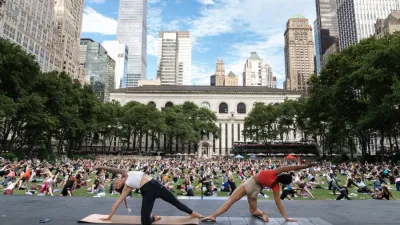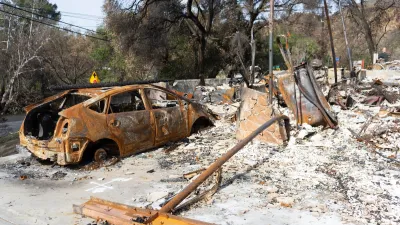Far from the drab and claustrophobic mental health facilities of cinematic fame, Ohana aims to serve patients in an aesthetically soothing, nature-driven environment.

In a piece for Bloomberg CityLab, Alexandra Lange describes a mental health facility in Monterey, California designed with youth in mind, one that uses mass timber and soft furniture to create a comforting, open, and light-filled space that bucks the stereotype of the sterile, brutalist mental health ward.
The overall aesthetic of Ohana could be described as 21st century prep school, except here youth are not molded into cookie-cutter members of the elite but provided with the tools to mold themselves. Instead of long, straight, whitewashed hallways, there are curved, sunlit, wood-framed corridors. Instead of being surmounted by a timekeeping belltower, the highest point is the eyebrow curve of the lobby roofline, supported by visible glue-laminated timber beams and columns, directing the gaze out to the hills and up to the sky.
The facility also features expansive hillside views from its south-facing rooms and art selected to appeal to young viewers. “Outside, on the terrace, raised beds will soon be absorbed into the clinic’s programming via a garden club, while the rest of the landscaping, designed by Monterey firm BFS Landscape Architects, emphasizes plants like mint, lavender, and rosemary, whose bioactive phenols can activate the immune system and help with sleep.”
The facility works with health insurance and is funded in part by a $60 million endowment. Executive director Susan Swick hopes it can serve as a model for this type of care and offer evidence that it can achieve better outcomes for patients. “While Swick and her team collect data, Ohana is already making a statement, materially, that mental health care should not be secret, that better care is found in community, and that children deserve the best design.”
FULL STORY: How Design Promotes Better Mental Health for Children

Alabama: Trump Terminates Settlements for Black Communities Harmed By Raw Sewage
Trump deemed the landmark civil rights agreement “illegal DEI and environmental justice policy.”

Planetizen Federal Action Tracker
A weekly monitor of how Trump’s orders and actions are impacting planners and planning in America.

Why Should We Subsidize Public Transportation?
Many public transit agencies face financial stress due to rising costs, declining fare revenue, and declining subsidies. Transit advocates must provide a strong business case for increasing public transit funding.

Understanding Road Diets
An explainer from Momentum highlights the advantages of reducing vehicle lanes in favor of more bike, transit, and pedestrian infrastructure.

New California Law Regulates Warehouse Pollution
A new law tightens building and emissions regulations for large distribution warehouses to mitigate air pollution and traffic in surrounding communities.

Phoenix Announces Opening Date for Light Rail Extension
The South Central extension will connect South Phoenix to downtown and other major hubs starting on June 7.
Urban Design for Planners 1: Software Tools
This six-course series explores essential urban design concepts using open source software and equips planners with the tools they need to participate fully in the urban design process.
Planning for Universal Design
Learn the tools for implementing Universal Design in planning regulations.
Caltrans
Smith Gee Studio
Institute for Housing and Urban Development Studies (IHS)
City of Grandview
Harvard GSD Executive Education
Toledo-Lucas County Plan Commissions
Salt Lake City
NYU Wagner Graduate School of Public Service





























